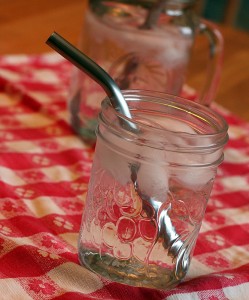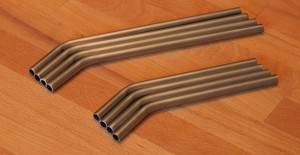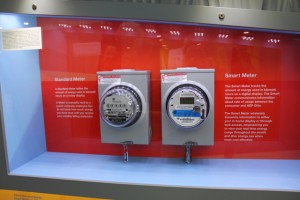Today, I have a guest post from Annie Warmke, resident farmer of Blue Rock Station Green Living Farm. Annie announced an intriguing project in the fall: Thanks for Nothing, a month of no spending. Now that she's half way through the experiment, I asked her to write a bit about how it's going.

As a business owner, a woman farmer, and a grandmother I tend to not be conventional about some of the things that people just seem to take for granted. About a year ago I had this realization that the stock market report had nothing to do with me. The next realization came in the form of wondering about happiness factors and how inspiring it would be to have a daily report on just how well all of us are doing with our health, our expectations, our families, and the whole picture of our lives. That led me to wonder what it would be like to not spend any energy (money, electricity, gasoline) for one month during the year. I told you I tend to be pretty far out…
Jay, my husband and business partner, came up with the idea of calling our month-long experiment “THANKS FOR NOTHING”. Our 18-year-old granddaughter, whom we call Miss America during the month, did not want to participate. We call her room “America” because she is still using up energy with not much thought, although we’ve been quite surprised at her mixed message that ranged from, “I am NOT participating” to “Last night I used the flashlight instead of turning on the kitchen lights.”
About two months before we began our experiment, one of our former engineering interns from France, Nans Thomassey, telephoned to say he’d like to do the experiment with us from his home in the Rhones-Alps with his partner Fanny Gonnet. What a novel idea - two generations living without money in rural Ohio and France during January. We hope to write a book together after our experiment.
Nans and I came up with some guidelines that would apply to how we cooked, and traveled. We have lots of food preserved – they do not. Fanny and Jay both need to drive the car (both families live in the rural area of their region) a couple of days per week to get to their job commitments. All of the fixed expenses for our households are automatically taken out of the checking account so it is easy not to spend money.
I felt like it was important that stay on the farm and only leave if I had a ride with someone else – ride sharing is not new. I do not use electricity except during the day, and that is only to run my computer. I use an old-fashioned cord phone for everything. At 5:15 PM, the time the US weather service declares is sun down; we turn off all the electricity (except for Miss America’s room), and live by candlelight, solar lights, postage stamp-sized LED lights for reading, and go to bed early. Since we tend to get up super early (Jay at 5 AM to write) this has not been a problem.
One of the first planning strategies was a menu for 31 days. It’s not unusual for me to generate menus for one or two weeks at a time, sometimes for 15 or 20 people, but it was a bit more of a challenge to generate three meals a day for such a long period of time, and include variety, healthy food, and know that all of the ingredients needs to exist prior to the beginning of the project start up.
Another challenge for me was the commitment I made to Nans that I would tell people who visit, and we’re hoping lots of folks will join us for an afternoon or even a couple of days, that they need to bring something to contribute to the experiment – candles, firewood, a bale of hay, or food. It’s my hope that folks will come for tea, and bring us their “good humor”, as Nans would say. I’m used to being the one who gives the food, and it was with a cringe that I asked my first luncheon guests to bring something. My friends arrived with candles and food telling me that it was about time they reciprocated since I was the one always feeding everybody. That was a relief to hear.
So far I’m having the time of my life. I’ve been writing a blog, documenting the daily happenings with photos, and enjoying the company of lots of visitors. This week several former interns will be here for two days and I’m hoping we’ll manage to play some hearty games of euchre by candlelight.
My friends think it would be impossible for them to not go shopping, or not to go anywhere or to cook every meal at home. For me, this life is such a gift, and having an excuse to say “no” to going to town, or thinking about money is like a restful vacation.
One thing I’ve discovered is what an under utilized resource the woodstove is for cooking. I’ve often used the top of it to heat things, or warm bread but during January I’m using it every day to keep the teakettle water hot, and to cook soups or bake potatoes. Yesterday I remembered that I have an old-fashioned canning stove that I used for cooking before we lived in the house. I spent the morning looking through the barn for it, but to my surprise it was still in tact and ready to work for us. Right now I’m baking a butternut squash soufflé in it.
Another realization is that we have so much food – I’m big on preserving food and the menu centers around mostly the food we’ve produced here at Blue Rock Station. Jay went up to the freezer this morning to bring back some butter and remarked that it seemed like it is just as full as when we started the THANKS FOR NOTHING MONTH. He’s probably right because when I make soup or pizza crusts or other items on the menu I often make extra to freeze for “fast food” when I’ve been too busy to get the meal started early enough in the day, or I’m tired and don’t want to make something from scratch.
On February 1st (I’m saying this at day 10 of the experiment), I think we will be talking about how we can incorporate some of the things we’re doing right now into our everyday habits. Of course we’ll still be using up the food we’ve preserved, and definitely thinking about what we want to grow during the spring, summer and fall growing seasons.
I’m reading several cookbooks rights now – my favorite being A Great Bowl of Soup edited by Christine Byrnes. It’s my plan to have made some of the recipes in that book during one of the days I can’t be outside much (we’ve had such great sunshine for several days) so maybe I’ll be thinking more exotic and wild at the beginning of the next month – you never know.
To learn more or follow my blog visit www.bluerockstation.com
MORE ABOUT ANNIE WARMKE: Blue Rock Station is a sustainable living farm located in southeast Ohio. Annie Warmke is the resident farmer who raises and milks goats, tends llamas and has a flock of rare breed chickens. She’s currently raising a stray bull calf that was found near an oil well (amazing to think about), and she was the contractor that built Ohio’s first Earthship, a house made of re-used materials including cans, bottles and rammed-earth tires. Annie and her husband, Jay Warmke write mini-books on their work with topics including constructing a straw bale garden chalet, creating walls with rammed-earth tires, solar cooking, natural gardening, and natural health for goats, and also natural health for cats and dogs. Their textbook, Green Technology: Concepts and Practices, is the first of its kind. They’re currently finishing up a book called WHEN THE BIOMASS HITS THE WINDTURBINE. To visit their farm or attend a workshop register on the Blue Rock Station events page.















